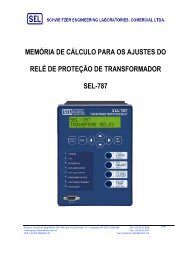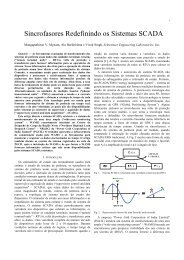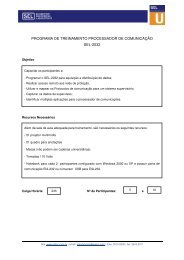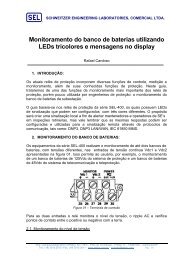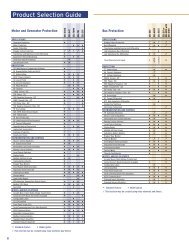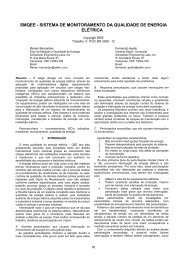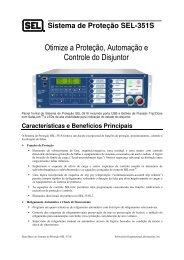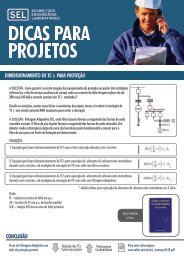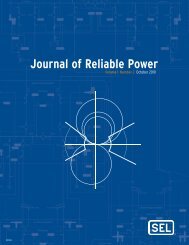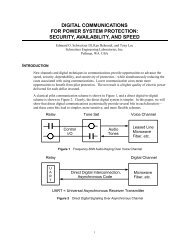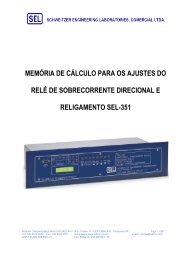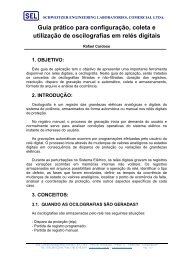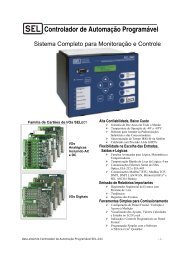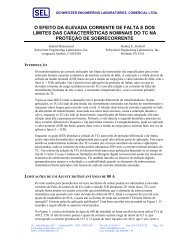Journal of Reliable Power - SEL
Journal of Reliable Power - SEL
Journal of Reliable Power - SEL
Create successful ePaper yourself
Turn your PDF publications into a flip-book with our unique Google optimized e-Paper software.
3<br />
C. Short Line Applications<br />
A short transmission line will generally have lowimpedance<br />
and short length values. On an R-X diagram, like<br />
the one shown in Fig. 2, the line impedance is electrically very<br />
far from the expected maximum load. For some applications,<br />
the line impedance reach (Zset) values challenge the<br />
measurement accuracies <strong>of</strong> the relay itself.<br />
Even for a ground fault with no arc resistance (Raφg equals<br />
zero), the Rf component will have the value <strong>of</strong> the tower<br />
footing resistance, as discussed previously. Mho ground<br />
elements have an intrinsic ability to expand and accommodate<br />
more Rf. This expansion is proportional to the source<br />
impedance (Zs), as shown in Fig. 2 [9]. However, if the tower<br />
footing resistances are in the range <strong>of</strong> the line impedances,<br />
which add to Rf, the mho element will have difficulty<br />
detecting faults even with no arc resistance. The situation is<br />
negatively amplified if the source behind the relay is very<br />
strong—implying a very small Zs.<br />
D. Directional Overcurrent<br />
Directional overcurrent protection is a more sensitive fault<br />
detecting technique than any type <strong>of</strong> distance element [1][10].<br />
The reach <strong>of</strong> these elements varies with the source impedance<br />
<strong>of</strong> a transmission network. Ground directional elements are<br />
polarized with zero-sequence or negative-sequence voltage.<br />
Negative-sequence polarization is also used for phase<br />
directional overcurrent protection. Other phase directional<br />
schemes are also possible.<br />
In line protection schemes, directional overcurrent is used<br />
as a backup scheme for pilot channel loss.<br />
Directional comparison pilot relaying schemes compare the<br />
direction to the fault between two or more terminals. It is<br />
recommended to include directional overcurrent elements (67)<br />
to complement the traditional distance elements (21), as<br />
illustrated in Fig. 3.<br />
jX<br />
Load<br />
Zset<br />
Rf<br />
Fig. 3.<br />
Directional comparison with directional overcurrent elements<br />
Zs<br />
R<br />
Pilot schemes for ground directional overcurrent, as shown<br />
in Fig. 3, will make up for any lack <strong>of</strong> sensitivity <strong>of</strong> mho<br />
elements for short lines. In fact, greater sensitivity is achieved<br />
by using directional overcurrent elements in the scheme,<br />
regardless <strong>of</strong> the types <strong>of</strong> line and distance elements.<br />
Fig. 2.<br />
Short line apparent impedance<br />
Quadrilateral ground distance elements can provide a larger<br />
margin to accommodate Rf. These elements are better suited to<br />
protect short lines. There are some limitations in the amount<br />
<strong>of</strong> Rf that they can accommodate (see Section IV).<br />
Nevertheless, their performance is better than that <strong>of</strong> a mho<br />
circle.<br />
The situation for phase fault detection is similar to that <strong>of</strong><br />
ground fault detection in short line applications. If the<br />
expected arc resistance is approximately the same magnitude<br />
as the transmission line impedance, the mho phase circle will<br />
experience problems detecting the fault. In significantly short<br />
line applications, quadrilateral phase distance elements<br />
provide notably better coverage than a mho phase element.<br />
Nevertheless, it is accepted that directional overcurrent<br />
elements are the most sensitive fault detecting elements and<br />
should be included in pilot relaying schemes [1][3].<br />
E. Fault Resistance on the Apparent Impedance Plane<br />
Relay engineers use the apparent impedance plane to<br />
analyze distance element performance during load, fault, and<br />
power oscillation conditions, either with mho or quadrilateral<br />
elements. In this plane, we can represent the apparent<br />
impedance for line faults with different values <strong>of</strong> Rf and line<br />
loading conditions. Fig. 4 shows the system that we used to<br />
calculate the apparent impedance for phase-to-ground faults at<br />
85 percent from the sending end.<br />
Fig. 4. <strong>Power</strong> system parameters and operating conditions to analyze the<br />
performance <strong>of</strong> distance elements<br />
Adaptive Phase and Ground Quadrilateral Distance Elements | 67



